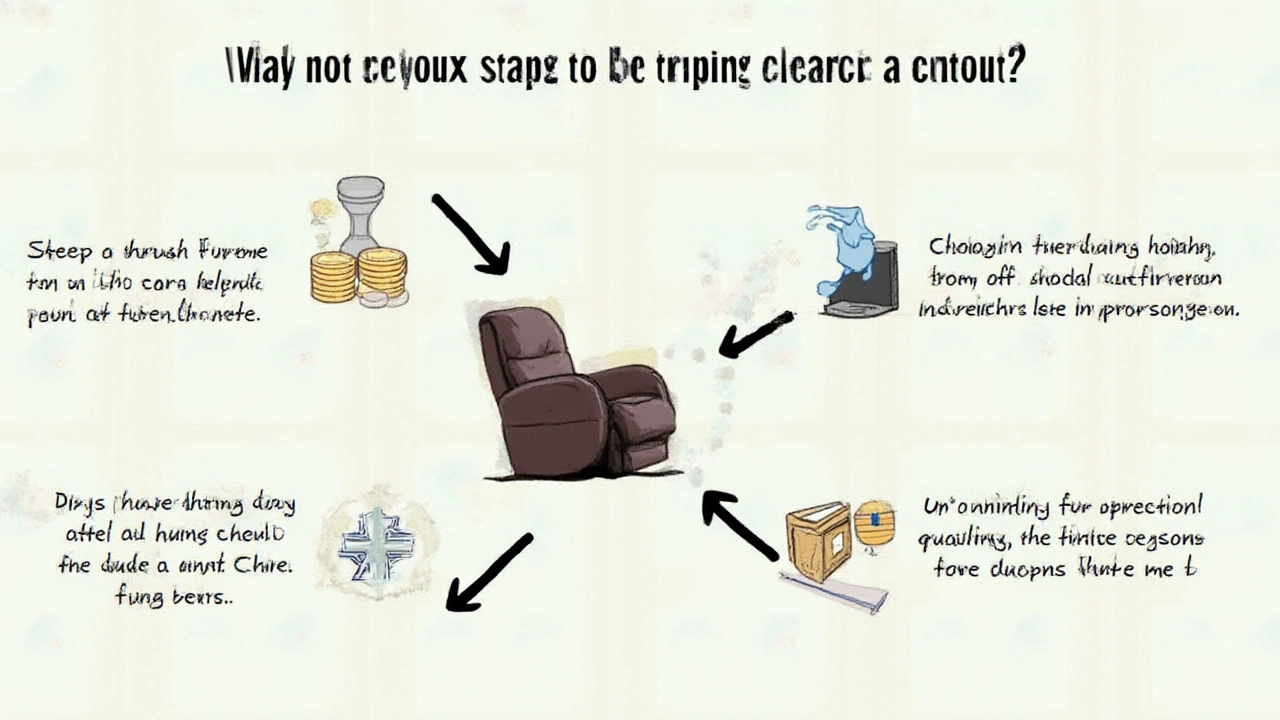Picture this: your back aches after a long day, and you sink into a plush Lazyboy recliner, hoping insurance might chip in. But will Medicare really help pay for that comfort? The answer is less obvious than it should be, and it trips up a lot of people hunting for the perfect medical chair. If you’re itching to upgrade to a Lazyboy and dreaming of Medicare covering the cost, you’re in for a bit of a reality check—and a fascinating journey through a tangle of health coverage rules you probably never signed up for.
What Does 'Medicare Approved' Actually Mean?
The term 'Medicare approved' gets tossed around a lot, but let’s get brutally honest—it’s got more rules than a neighborhood book club. When folks talk about Medicare approving an item, they mean it meets the specific requirements set out by the U.S. Centers for Medicare & Medicaid Services (CMS)—like safety, medical need, and structure. In Medicare’s lingo, these items fall under 'durable medical equipment' (DME). Think wheelchairs, walkers, hospital beds—not just any plush recliner you find at a furniture store, no matter how good it feels.
Here’s the first curveball most people don’t see coming: to get DME covered, Medicare doesn’t just need a device to be comfortable or even helpful—it has to be medically necessary. That means your doctor needs to write a detailed prescription, and the equipment must be used for a diagnosed medical condition. Most recliners, even highly engineered ones from Lazyboy, don’t get stamped as DME. Why? They don’t generally have all the features—like electric lift—you’ll find in specialized lift chairs designed for those with mobility issues.
Medicare’s list of approved DME is surprisingly tight. Classic Lazyboy recliners aren’t on it. However, Medicare may partially cover what it calls a 'lift chair'—and only the electric lifting mechanism, not the whole chair. Here’s where it gets confusing: If you find a Lazyboy with a built-in lift mechanism, Medicare might help, but only for that mechanical part, and only if the supplier is enrolled in Medicare. The rest—fabric, cushioning, colors, or cup holders? Those are on your tab. The lift chair supplier also has to be Medicare-approved, and you need to follow the goldilocks pathway (not too many, not too few steps): see your doctor, get paperwork, find an eligible supplier, submit everything, and hope your claim is accepted.
This is the part most folks don’t expect: there’s rarely such a thing as a 'Medicare approved Lazyboy.' Even the term itself can be misleading. Some retailers market lift chairs as 'Medicare eligible,' but that doesn't mean Medicare will automatically pony up. You need the right paperwork, a qualifying medical condition, and a specific kind of chair with a lift feature. So don’t get swayed by slick sales tags—read the fine print and talk to your doctor.
Here’s a handy table breaking down what Medicare typically covers when it comes to lift chairs:
| Feature | Medicare Coverage |
|---|---|
| Standard Recliner Chair | No |
| Lift Chair (Mechanical Lifting Mechanism Only) | Yes, partial coverage |
| Lift Chair Frame & Upholstery | No |
| Chair Purchased Without Doctor's Prescription | No |
| Lift Chair from Non-Medicare Supplier | No |
So, are Lazyboy recliners Medicare approved? Not by default. Only specific models with a medical lift, bought under the right circumstances, come close—and even then, you’re not getting the whole chair covered, just the lift system. This is why so many shoppers end up surprised at checkout. If it sounds complicated, well, welcome to the world of healthcare policy. But keep reading, because there are ways to bridge the gap between comfort and coverage, if you know where to look.

How to Qualify for a Medicare-Funded Recliner or Lift Chair
If you’re still reading, chances are you or someone you love needs something more substantial than a soft seat. Medicare sees lift chairs as DME only if they help you get up due to medical necessity. Think arthritis, severe balance problems, or muscle weakness—that’s the level of need Medicare expects. So where do you even start?
The first step is seeing your doctor; and not just in passing. You’ll need a face-to-face visit where your doctor reviews your mobility issues and determines whether a lift chair is medically necessary. Their notes have to mention why you can’t get up from a regular chair and whether other options have been exhausted. If you’re like me, and tend to underplay your pain, don’t. Be specific about what daily activities are tough: standing up, sitting, moving around. The more detail, the better. Doctors document everything, and Medicare reviewers want the facts.
Next, your doctor needs to fill out a written prescription, often called a Certificate of Medical Necessity (CMN). It spells out your diagnosis, what the chair will help with, and a signature. Here’s an insider tip: If your doctor’s office handles this kind of paperwork often, ask for help navigating the process. Some clinics streamline the whole thing, or even send the forms straight to suppliers, making your life a lot easier.
With documents in hand, you’ll need to find a Medicare-enrolled supplier. And this is key! Not all furniture stores that sell Lazyboy lift chairs work with Medicare, so ask up front. The supplier’s billing department usually submits the claim directly to Medicare. If they don’t, or if they’re out of network, Medicare probably won’t reimburse you—even if you qualify. I’ve overheard a neighbor at church rant about getting stuck with the full bill because he bought from the wrong place. Don’t let that be you.
So here's what the claims path usually looks like:
- Get a face-to-face exam with your doctor.
- Receive a signed Certificate of Medical Necessity.
- Find a Medicare-enrolled supplier who offers qualifying lift chairs.
- The supplier submits your paperwork and claim.
- Medicare reviews and (if approved) covers part of the cost—just the lift mechanism.
You’ll almost always have to pay 20% of the Medicare-approved amount, plus any extra cost for fancy upholstery, tech features, or add-ons. Medicare Part B is what covers DME, and if you have a supplemental plan, it might pick up some (or all) of your share, depending on your coverage. Keep an eye on your deductible as well. In 2025, the Medicare Part B deductible is $233, so if you haven’t met it, that’ll kick in first.
The paperwork dance pays off, but don’t expect instant results. Approval can take a bit—weeks, even. Also, even if Medicare greenlights the mechanism, you’ll be paying for a chunk of it, and all the bells and whistles are up to you. I helped my aunt go through the process last winter, and even with everything lined up, she still had to fork out extra for her favorite fabric and headrest. But hey, at least Medicare took a bite out of the bill.

Tips for Getting the Most Out of Your Recliner Search
Not everyone needs a medical lift chair, but if you do, shopping smart matters. Lazyboy makes some gorgeous models, but not all of them meet Medicare’s requirements—even if the sales pitch makes it sound easy. Here’s how to save yourself time, frustration, and sticker shock.
- Double-check which models actually come with a built-in medical lift. Ask for details, not just "lift" in the name.
- Get a detailed price breakdown up front. Ask what’s covered, what’s not, and what your final cost could look like after Medicare chips in.
- If you’re considering used lift chairs, keep in mind: Medicare only pays for new equipment from approved suppliers. Secondhand or private sales aren’t covered.
- Look into local resources. Some community programs, especially those for seniors or veterans, help cover that 20% out-of-pocket cost or connect you with funding for medically necessary furniture. Don't miss out on local charities or civic groups—they sometimes sponsor this kind of help.
- Read reviews from buyers who also used Medicare. Forums and social media groups for seniors or caregivers are a goldmine for real-world tips—sometimes you’ll even find people sharing their paperwork journeys step-by-step.
- If you have a Medicare Advantage plan, rules might be tighter or looser than with Original Medicare. Always call your insurer before you buy anything. Some plans have preferred suppliers or even offer extra discounts, but only if you use their process.
- Keep every receipt, prescription, and form you get. If there’s a dispute later—and there can be—documentation saves the day.
And for anyone still wondering, insurance rarely covers ordinary Lazyboy recliners, no matter how sublime they feel. But the world of lift chairs is surprisingly varied. Some look exactly like classic recliners, while hiding a medical-grade motor inside. That’s where a little research pays off. A friend of mine spent weeks hunting for the right chair after a knee surgery and finally landed on a Medicare-approved lift model that didn’t look clinical at all. Her only regret? Not starting the paperwork sooner.
If you want insurance to help, work with your doctor and a reputable supplier. Never buy first and ask questions later. Bring up what you want at every step—medical need, comfort, and style—and don’t forget to check for newer models and tech, as the DME list sometimes updates. Direct questions save you money. If a supplier dodges your Medicare questions, that’s a red flag.
And if you happen to find a Lazyboy model that ticks all the Medicare boxes, congratulations—you’ve hit a rare sweet spot between luxury and necessity. Just remember, comfort is priceless, but paperwork is part of the package.


Write a comment